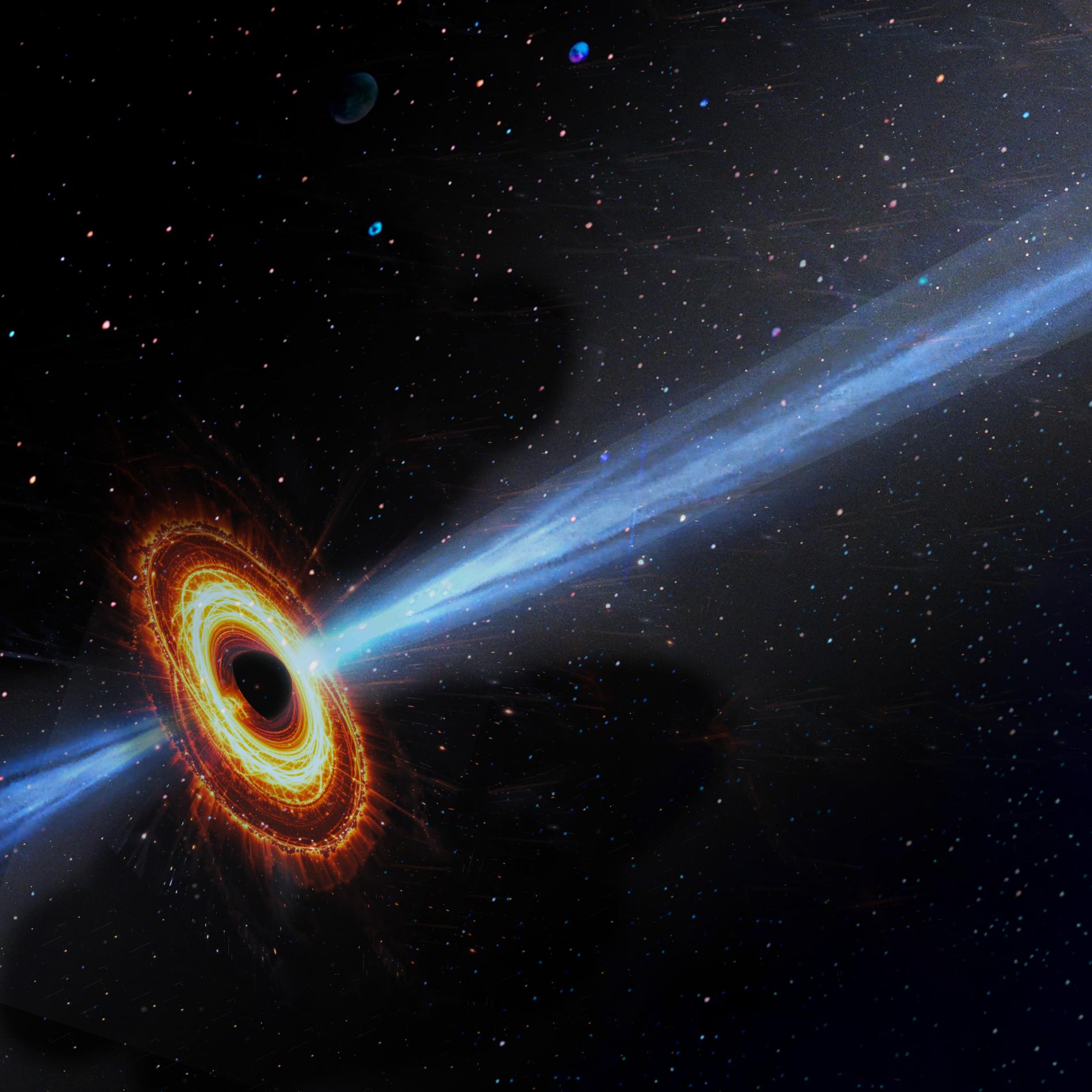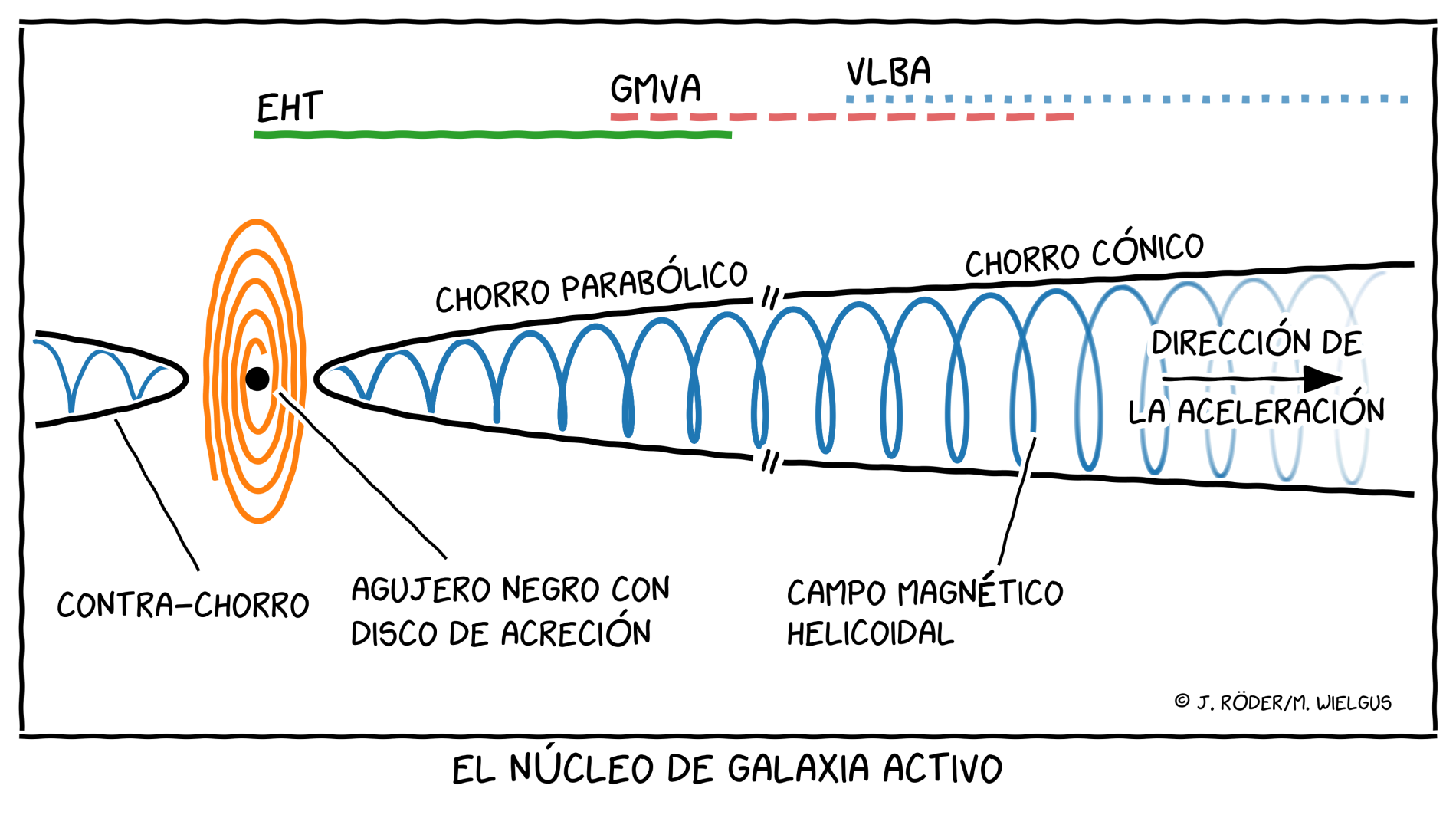Acceleration in supermassive black hole jets that defies theoretical predictions discovered
A study co-led by the Instituto de Astrofísica de Andalucía (IAA-CSIC) reveals deviations from established models of the jets formed in supermassive black holes
The finding is based on observations from the Event Horizon Telescope (EHT), whose high resolution has allowed for an unprecedented analysis of jets at close distances from supermassive black holes in the active cores of certain galaxies
Active galactic nuclei (AGN) are regions at the center of some galaxies where a supermassive black hole emits an enormous amount of energy as it feeds on surrounding matter. For decades, the study of AGN has been key to understanding the extreme physical processes occurring near these black holes, including the jets—powerful streams of matter and energy—that they launch into space.

Artist's impression of an active galaxy nuclei. Credit: Juan Carlos Algaba
Recently, an international team led by researchers from the Instituto de Astrofísica de Andalucía (IAA-CSIC) and the Max Planck Institute for Radio Astronomy (MPIfR) in Germany has demonstrated that the current theoretical model fails to fully explain what occurs in the regions near the black hole, where these jets form. "The basic model cannot be a perfect description for all jets; it is most likely accurate for only a small fraction of them," says Jan Röder, researcher at IAA-CSIC and leader of the study. "The dynamics and substructure of jets are complex, and observational results can be affected by astrophysical degeneracies."
The study, published in the journal Astronomy & Astrophysics, is based on multi-wavelength observations of AGN to investigate how black holes launch relativistic jets. The sixteen sources were observed in 2017 during the first campaign of the Event Horizon Telescope (EHT). "The extreme resolution achieved by the EHT allowed us to study jets closer than ever to the supermassive black holes at the centers of these galaxies," notes Jan Röder (IAA-CSIC). The team analyzed the acceleration and magnetization of the jets by comparing results obtained at different frequencies and angular scales.

Gradual increase of the brightness temperature as the distance to the supermassive black hole increases. Credit: J. Röder/M. Wielgus
CHALLENGING THE CLASSIC MODEL: JET ACCELERATION IN ACTIVE GALACTIC NUCLEI
To understand the complex physics of the powerful plasma jets emerging from supermassive black holes in active galactic nuclei and extending thousands of light-years into intergalactic space, observations with extreme angular resolution are required. This allows astronomers to closely study the region where these jets form.
The Event Horizon Telescope (EHT) is a global network of radio telescopes that work together to form a virtual Earth-sized telescope, providing the necessary resolution to study black holes and their jets. The EHT is operated by an international collaboration of hundreds of scientists and was responsible for capturing the first images of supermassive black holes, in the centers of the Milky Way (Sagittarius A*) and M87. In addition to these primary targets, during its 2017 campaign, the EHT observed several active galactic nuclei (AGN).

Locations of some of the telescopes that make up the EHT, as well as the long baselines between the telescopes. Credits: ESO/L. Calçada
The most common model assumes that jets have a conical shape and contain plasma moving at a constant velocity. Moreover, it is believed that the magnetic field strength and plasma density decrease as one moves away from the black hole that generates them. To evaluate how accurate—or inaccurate—our understanding of jet evolution is, researchers compared EHT results with previous observations of the same sources. These observations were conducted with the Very Long Baseline Array (VLBA) and the Global Millimeter VLBI Array (GMVA), which explore much larger spatial scales than the EHT.
"Using the sample of sixteen AGN, we were able to obtain a broader perspective on jet behavior, compared to merely observing individual objects. This way, the results are less likely to be influenced by their respective unique properties," explains Maciek Wielgus, co-leader of the project at IAA-CSIC. This comparison made it possible to infer the evolution of jets from their origin to many light-years into interstellar space. "We observed that the brightness of the jets often increases with distance from the black hole, which clearly suggests acceleration," says the IAA-CSIC researcher.

Although alternative explanations exist for these new observations, such as deviations from conical geometry, the basic theoretical model clearly cannot fully reproduce the properties of jets near their origin. "Further studies are needed to fully understand the acceleration mechanism, energy flow, the role of magnetic fields in AGN jets, and their geometries. The expansion of the EHT network will play a crucial role in future discoveries about these fascinating objects," concludes Jan Röder (IAA-CSIC).
- A multifrequency study of sub-parsec jets with the Event Horizon Telescope
- https://www.aanda.org/10.1051/0004-6361/202452600
- Jan Röder - jroeder.astro@gmail.com
- Instituto de Astrofísica de Andalucía (IAA-CSIC)
- Unidad de Divulgación y Comunicación
- Amanda López – alm@iaa.es
- Emilio García – garcia@iaa.es - 649 407 445 (vía whatssap)
- Celia Navas - navas@iaa.es
- https://www.iaa.csic.es
- https://divulgacion.iaa.csic.es

